|
|
Review UMTS phone Samsung Z300
Samsung Z300. Live pictures

The company of Samsung headed for representing more UMTS models, several phones of the new line are rather interesting, and the Z300 is one of them. Look at it, the phone resembles the Samsung D600 in some way, though has plainer characteristics and another form-factor. Now the main Samsung's goal is to attract a wide audience to its 3G solutions, and the Z300 is just perfect for implementing the task. This model was primordially created as a rival for earlier launched Sony Ericsson V800/Z800.

The phone's dimensions exceed the ones of usual GSM clamshell's, however are quite appropriate in its class (89.4x47.4x25.4 mm). And a typical weight of 115 grams. Both young users and businessmen will like the strict design of the Z300. The body combines a glossy plastic and a dark-silvery surface. This combination adds some interesting appearance to the model making it look elegant.

A megapixel camera objective is on the front surface, and a non-impact flash is lower. The external screen is OLED, which allows viewing two lines with time and icons indicating signal level, battery charge and events always. The main part of the screen fades in the standby mode and gets active with an event or shooting in a closed mode.
 

The resolution of this 65K external screen is 80x64 pixels. The diagonal forms 1" with the physical size of 19x21 mm. You can set your own screen saver. The display is readable in the sun, however not as well as indoors.



A miniUSB headset slot is on the left (only original accessories suit). The connector is closed with a rubber shutter fixed to the body; it is not sliding but folding aside. Lower is a volume button and an IrDA gap on the same side. A strap hole is on the top of the phone. See a camera button on the right side, and a TransFlash memory card connector closed with a sliding shutter. The phone supports hot memory card change. And finally, a standard interface connector closed with a shutter fixed to the body is placed on the bottom end.


Look at the device and see symmetrical loudspeaker gaps on the top. The phone is equipped with stereo loudspeakers which gets standard for Samsung. Opening the phone with one hand is easy, inside you'll see a large screen (2", 176x220 pixels, 32x41 mm). That is a 262K TFT display. Today this display is one of the best on the 3G phone market.

A VGA-camera under the screen serves for video calls the 3G networks.

Due to the body size the keypad got large buttons, comfortable to work with. And only the disposition of fast menu and video call buttons rouses bewilderment, since they take the place of soft-keys, while the last ones are on the top. While working with the phone, I used to mistakenly press these separated buttons instead of the soft-leys. That is uncomfortable and spoils the whole impression of the phone, thus you'll have to concentrate on pressures and control them. A separate mp3 player button is on the very top.

A metallic 4D navi button has an OK one centered in it. The keypad backlighting is white, which makes characters on the keys seen well in various conditions.

The battery having no backlash is the back of the phone. The capacity of this Li-Ion battery is 950 mAh. According to the manufacturer the battery is capable of 180 hours in the standby mode and up to 3 hours in the talk mode. Under the condition of Moscow BeeLine network the phone worked averagely for 3 days with 40 minutes of talks and up to 45 minutes of using other functions. Recharging will take you about 2 hours.
Menu
As for the menu, the phone has not been changed any greatly, it resembles all the Samsung D500 derivatives. The main menu is shown as 9 icons with 3 in a row. Number navigation is supported. All the menus are lists, and the second submenu level allows moving with horizontal deviations. You can assign functions from the list to the navi pad. Generally, the menu division is quite logical and navigation makes no trouble.
 
 
Totally 53 MB of dynamically shared memory are provided.
 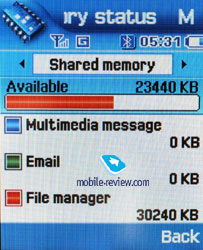
Phonebook. By pressing the right soft key, one can obtain the contacts in a form of a list containing all the files both from the phone's and the SIM-card memory. The first name in the list is backlit by default and the number is shown in the status bar (there is a special sign for numbers from a SIM-card). There is a fast search by first letters of a name; the phone can hold more than twenty of those for any possible language. By pressing the OK key, you enter in the view menu of a single file where you may see a small icon in case the name is matched with the image. Any graphic file or the pictures of your own may be used as such image. Up to five phone numbers of various types (cell, office, home, fax, etc.) may be kept for a name with one number as the main contact (it would become the first one by default). The fields are strictly fixed and there may be not two cell phone numbers entered. On the other hand, SMS/MMS can be sent to any number from the phone book once chosen.
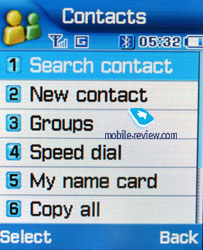 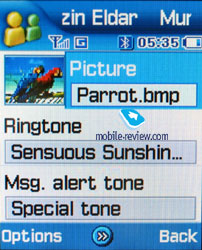
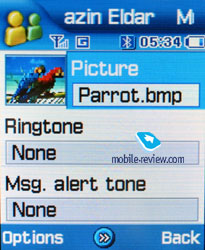 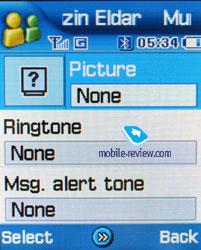
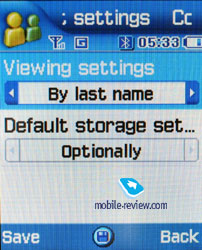 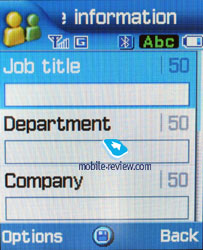
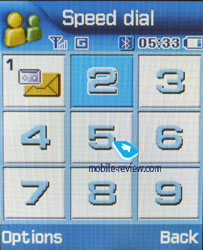 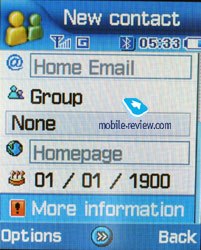
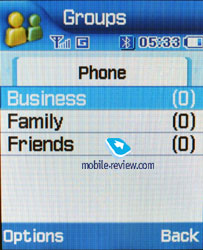 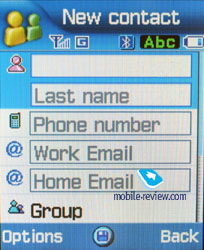
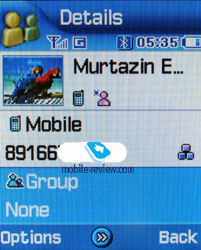 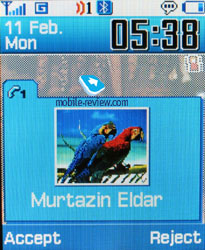

There are two fields for a Name and a Surname (search only by the first one) that are concatenated when displayed and the Name field goes the first. For example, if you entered Eldar Murtazin, it is displayed exactly in this manner. The length of each line is 20 symbols for any of the available languages. You may opt to alter the language while inserting the text as well.
Files in different languages are sorted out according to a rule - first it will be all files in the local language (Russian, for example), and then those in English. This is rather convenient and habit forming. Taking into account an option of fast language change during the search, it becomes clear that the files in different languages do not impede the work with this phone.
Let us return to the information entered for one name. Besides phone numbers, an e-mail address and a little text memo can be recorded. Any music file as well as composed MP3's can be chosen as a ring tone for the name. Three caller groups are preinstalled and out of any category. You can easily create a necessary number of groups, select a personal melody and image for each.

Up to 1000 names with all the data can be saved in the phone's memory. Even if all the available lines are not used, the number of names to be saved would remain a thousand. It is possible to indicate in the settings where the new numbers should be kept by default. There is an option of moving files from the SIM-card although not vice versa. According to the developers, PC is the best means of synchronization, MS Outlook in particular. Any file in the form of SMS/MMS, mail message or other text file can be sent quickly through Bluetooth to another device. There are no problems with sending and the phone book entry being transmitted to another device is precisely decoded without any trouble.
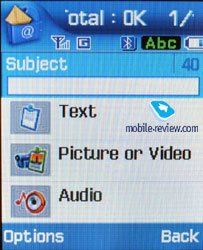
New names can be entered only through the main menu; the right soft key always calls for the name list only. You can create your own visit card; its format would be the one of a regular file from the phone book.
There can be up to eight numbers in the speed dial list; peculiar is the fact that separate numbers of one name may be in this list as well. The subtitle of the chosen name (but not of the phone type) is displayed on the buttons.
The comparison of this phone book with phone books of other phones is rather interesting. It is not fully compatible with MS Outlook's layout as the phone has fewer fields. Consequently, the phone gives way to all the smartphones (the phone book options are the most extended ones in those). The phone book is moderate here when compared to the phones such as Siemens and Alcatel. However, the model is a decent rival to all other phones. The phone also has a very convenient phone book, which is a pleasure to work with.
When receiving a call, a picture is not displayed on the full screen, but only on a part of it (approximately 120x140 pixels). In a way, this can be seen as a big disadvantage, however the developers may resolve this shortcoming in some time. Another serious disadvantage of this phone is the lack of voice recognition. Users of a Bluetooth-headset or an in-car speakerphone are particularly interested in this function.
Call lists. Up to twenty phone numbers are displayed in each list. There is a combined list of all the last calls with an icon indicating a call type. Tilting the scroll key horizontally, you may switch quickly from one list to another. The date and the time of the call (it's duration is not kept) can be seen for separate files. As always, the overall time of the calls and their prices can be viewed in this menu (this service has to be installed).
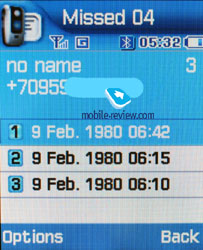 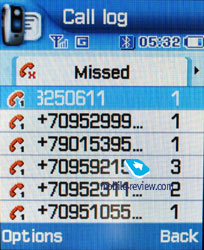
Messages. Working with different types of messages is done through separate submenus. Let us begin with short messages. Up to 200 messages can be saved in the phone's memory; the phone supports the EMS standard compatible with Nokia Smart Messaging. The support of various encodings chosen by a user (GSM or Unicode) is a very nice feature here. The black list (no messages from the entered there numbers are shown) containing up to 10 numbers is a unique feature. T9 functions very well and is quick and easy to use.
 
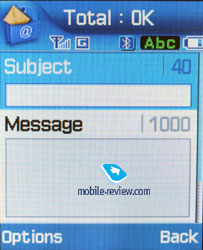 
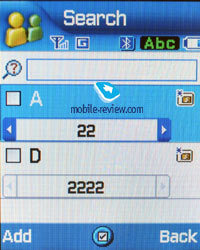
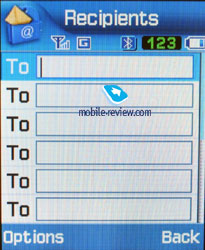 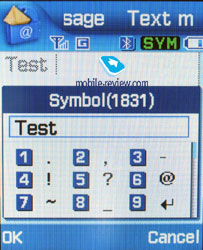
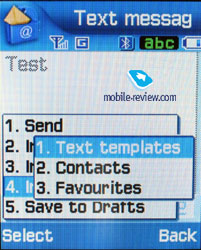 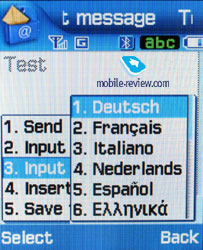
 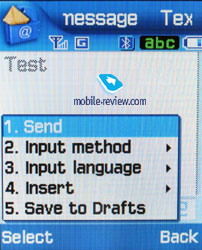
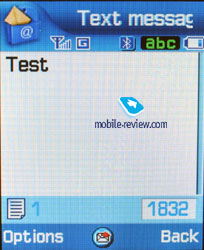 
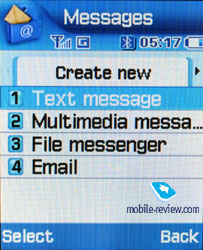 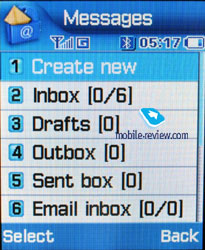
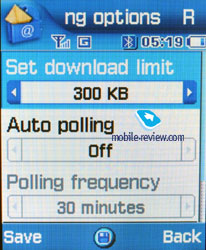 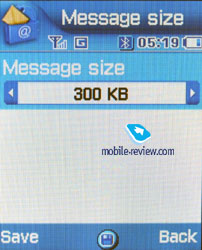
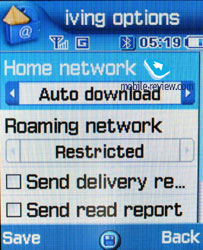 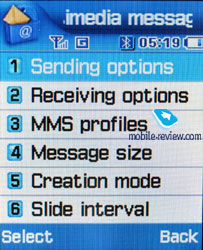
MMS. The interface for multimedia messages is very nice; the messages can be saved in several folders at once and right away. There are no size restrictions for a message to be received although an outgoing message should not exceed 295 KB. As for additional services, the rejection of advertising messages, the option of the message receipt in the roaming and the home network should be mentioned. The messages are saved in the general memory since there is no special memory for them.
Mail client. POP3/SMTP boxes and several tracking files are supported. Besides the title downloading, the phone can receive the letter itself. As for attachments, only the graphic files (GIF, JPEG) are supported. When sending a letter, you can attach a picture from the integrated camera to it. Overall, the mail client is nice although it does not stand out with an immense number of functions. There is also an option of creating templates.
Applications. Java World is the first menu item; up to four MB of memory are available in the phone for various programs. This is a separate memory allotment and is used for Java only. MIDP 2.0 version allows the use of the graphic reach and three-dimensional games. There are four games preinstalled in the phone - Bobby Carrot, Airship Racing, Freekick and Archangel.
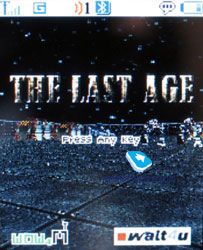 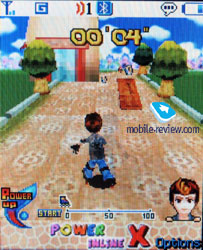
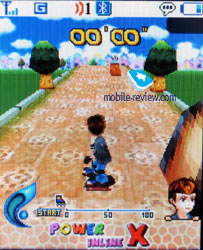 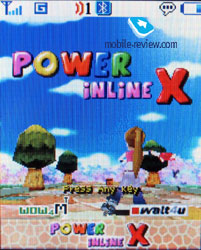
 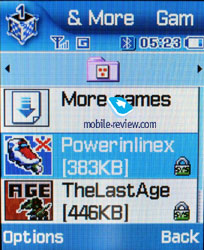

MP3 player. An integrated mp3 player supporting random track reproduction, sequential and cyclic, is available in the phone. Mp3 files can be downloaded into the phone both directly through Bluetooth and through a synchronization program. Files may be of various names and tags (in Russian language as well!). The bit rate of the files is not that important since the phone accepts all the possible formats. We came across several problems with the files recorded through VBR since the phone would report an error and reject downloading. However, a number of the same VBR mp3 files were successfully downloaded and reproduced without any problem.
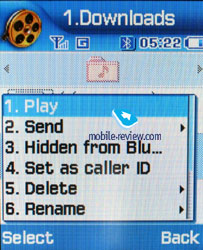 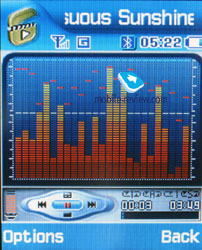
The title of the track playing is displayed as well as the overall number of different composition. An equalizer is of an entertaining nature; there are no separate settings (only a possibility to choose from classic, rock, jazz and normal reproduction). The tracks can be played through the stereo headset as well as through the speakerphone. The volume has ten levels. The user is welcome to create play lists of his/her own. There is 90 MB of memory available for mp3 compositions, which is enough for recording more than an hour and a half of qualitative music. The player is realized neither better nor worse than ones by other manufacturers. Everything is quite plain.
Dictaphone. You can record up to several hours of voice memos with the number of files being unlimited. The time restrictions for one recording are set by a user and can vary from 30 seconds to one hour in duration. All the files are kept in a separate folder in the memory. The dictaphone cannot record a conversation, since it only works in stand-by mode. Two types of equalizers are offered in the settings with one of them meant for noisy surroundings. The recorder can function well during lectures, conferences and presentations. The phone is a partial substitute for a digital tape recorder.
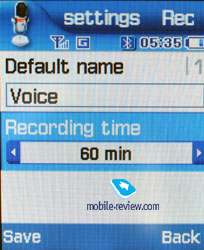
World time is displayed for two chosen cities. Everything is nice and simple here.
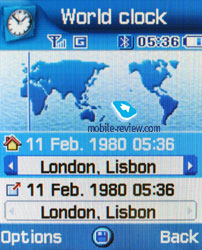
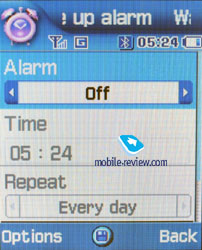
Calculator. Everything is nice and simple here.
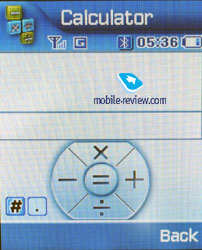
With a converter, you can operate with different units of measurements as well as with the currencies.

Organizer. Alarm clock. The phone is equipped with three alarm clocks. One is meant for mornings and can be set for selected weekdays as well as for weekends. For each of the alarm clocks there is a selection of five melodies although mp3 compositions cannot be used here. It is up to a user to indicate in the settings whether the phone would turn on automatically in the time of the event or not.
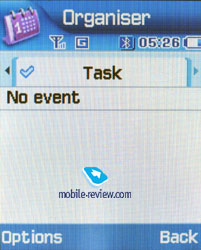 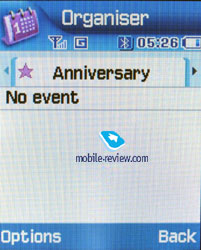

Calendar. Up to 400 events of four types - meeting, affair, anniversary and others, can be saved in the phone's memory. The day and the time as well as its end are indicated for each file. A signal can be set for the interval during which it has to go off; repetitive events are available for setting.
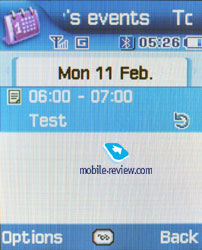 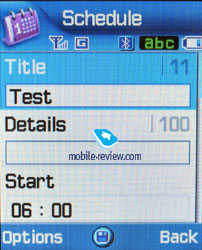
 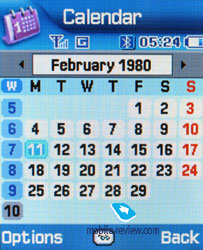
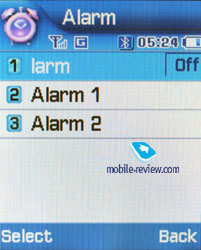 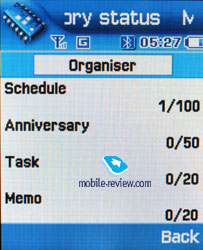
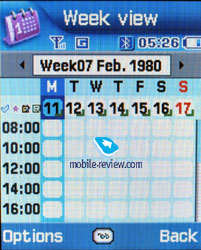 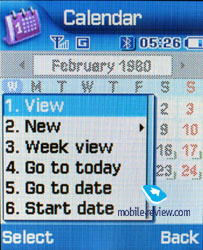
The weekly and the monthly calendar are very convenient with each type of the event having its own color.
Also a user can create up to 50 text memos up to 100 characters in length each. No alerts or signals are preserved for these memos.
WAP. There is a wap-browser version 2.0 similar to some phones by Nokia and Sony Ericsson using http protocol. That means in some networks operator's setting is required.

Settings. That is traditional that you are allowed to choose font colour in the standby mode, protect any section of the phone with a password (messages, short messages, organizer and so on). You may set the time for backlighting on and its brightness.
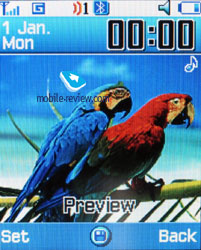 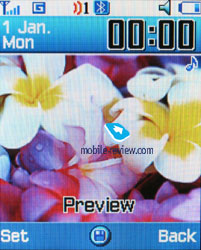
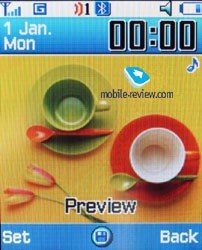 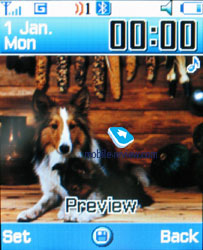
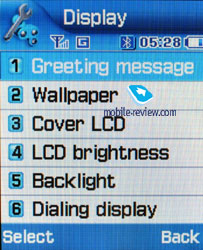 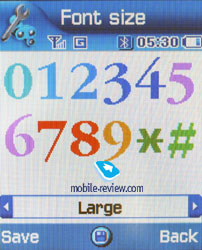
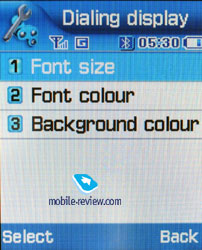 
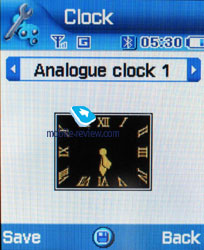 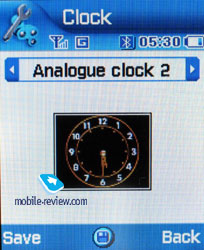
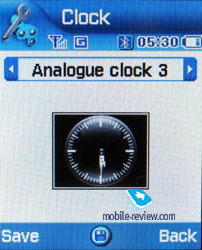 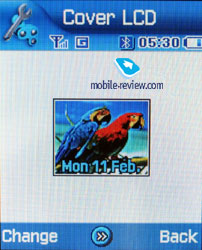
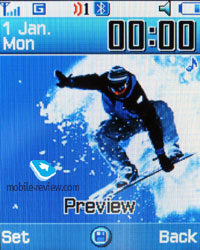 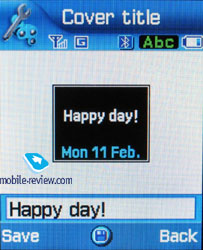
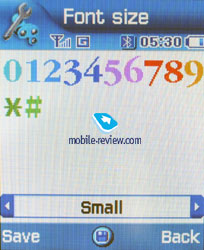 
Themes are absent in the phone that is different to Sony Ericsson and they are replaced by Skins. There are two of them and two of them allow changing not only a colour scheme but a header also, it gets roundish. In some kind that is the first prototype or if you want the first step to a possibility to change the interface completely, let's see what will the future models bring.

File Manager. Here are all the files such as music, pictures, video and sounds. All the uploaded files get here. The disadvantage is files sometimes are not displayed in the list immediately, you need to leave the menu and enter it again.
Camera. The megapixel camera module is similar to the one of the E720. And the resolutions supported are the following - 1152x864, 640x480, 320x240, 176x148, 160x120 pixels. Compression quality may be Super Fine, Fine, Normal, Economy. Shutter sound may be turned off.
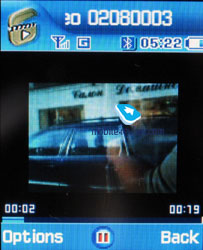 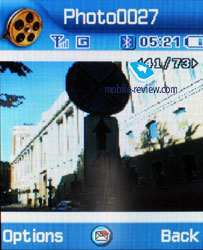
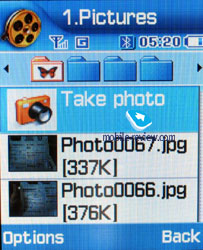 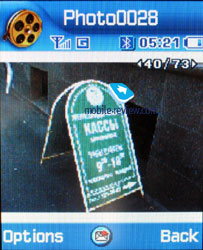
The quality of the pictures is higher outdoors on a bright sunny day, though the photos are quite bearable even on a dull day, however grain does appear.
- Sample
photo outdoors, 1152x864, Super Fine, JPEG, 221 KB
- Sample
photo outdoors, 1152x864, Super Fine, JPEG, 213 KB
- Sample
photo outdoors, 1152x864, Super Fine, JPEG, 213 KB
- Sample
photo outdoors, 1152x864, Super Fine, JPEG, 273 KB
- Sample
photo outdoors, 1152x864, Super Fine, JPEG, 264 KB
- Sample
photo outdoors, 1152x864, Super Fine, JPEG, 259 KB
- Sample
photo outdoors, 1152x864, Super Fine, JPEG, 165 KB
- Sample
photo outdoors, 1152x864, Super Fine, JPEG, 243 KB
- Sample
photo outdoors, 1152x864, Super Fine, JPEG, 182 KB
- Sample
photo outdoors, 1152x864, Super Fine, JPEG, 236 KB
The quality of the pictures really decreases indoors in the dark, which is quite understandable for a CMOS-matrix.
The device supports such effects as Gray scale, Negative, Sepia, Emboss, Sketch, Antique, Moonlight, Fog.
Samples of various effects applied to photos taken indors, zip-archive, 1.31 MB.
Frames are supported for 320x320 pixels photos, new ones may be uploaded. Flash can work automatically or be set manually. Timer may be set for 3, 5 or 10 seconds.
Also there is a possibility to take 6, 9 or 15 photos in a series; you can set two types of speed for each case (normal and high). Finally, the device supports matrix photos (2x2, 3x3).
The same set of effects is provided when recording video. Four resolutions are supported- 352x288, 320x240, 176x144, 128x96 pixels. The quality may be set just like for photos (four levels). The video looks not bad on the screen; you can also switch sound off. You are not limited in clip duration, write as long as free space allows.
- Sample
video, 352x288, Super Fine, outdoors, 1.82 MB, mpeg4
- Sample
video, 176x144, Super Fine, indoors, 0.7 MB, mpeg4
- Sample
video, 352x288, Super Fine, outdoors, 2.43 MB
- Sample
video, 352x288, Super Fine, street from a car window, 2.4 MB
That is the first time the quality of the video is quite acceptable both on the phone screen and on a PC. You can see the clips recorded in a good quality, though the picture shakes when shoot (the samples provided here show the same because of your humble servant's walking). The device should be praised highly for the video quality.
Synchronization with PC. Synchronization is made using Bluetooth and a cable. Easy Studio 2.0 will be included into a delivery kit (or provided on the manufacturer's site) that is a renewed version. There are many changes comparing to the first version and we won't tell about all of them. I'll only note that this software is similar to programs for synchronization by other manufacturers in some kind (in a maximal configuration) but also provides its own capabilities.
Impressions
The connection quality is high and rouses no complaints. The volume of the 64-tones polyphonic alert is the maximum for today and the device may be heard in various sound conditions. The power of the vibra is average or a bit higher and it may be felt in the majority of cases.
 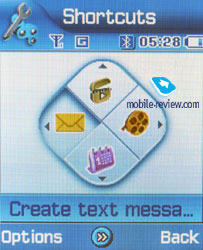
The model doesn't get out of the last company model line. The advantages are support for UMTS, stereo loudspeakers, hot memory card change, and as a result, normal use as an mp3 player. This phone has nothing to distinguish with; it is a typical product with a basic functionality. The design is pleasant. This product is quite interesting for 3G networks, though the Samsung E720/E730 is better for GSM ones. Costing 450-500 USD the model doesn't look very expensive, but the price is right due t the lack of many rival phones. And only Sony Ericsson Z800/V800 may compete. These phones seemed more preferable despite the bigger size. In both cases these phones a of the previous generation and evidently loose to the devices that are to appear in the end of the year or in the beginning of this autumn. Though we consider the Samsung Z300 an interesting assortment model, a device that may have rather a low price by the end of the year.
The disadvantages noticed are sometimes unstable Bluetooth work, spontaneous profile switch while listening to the media player actively. Working with memory cards is not cloudless sometimes, the phone refuses reading some cards, and we had to format them first. Photos by the camera at cold start (the first photo from the standby mode) sometimes have wrong exposition, which influences the quality badly.
Melody samples (mp3, 308 KB)
Eldar Murtazin (eldar@mobile-review.com)
Translated by Maria Mitina (maria.mitina@mobile-review.com)
Published — 07 July 2005
Have something to add?! Write us... eldar@mobile-review.com
|
News:
[ 31-07 16:21 ]Sir Jony Ive: Apple Isn't In It For The Money
[ 31-07 13:34 ]Video: Nokia Designer Interviews
[ 31-07 13:10 ]RIM To Layoff 3,000 More Employees
[ 30-07 20:59 ]Video: iPhone 5 Housing Shown Off
[ 30-07 19:12 ]Android Fortunes Decline In U.S.
[ 25-07 16:18 ]Why Apple Is Suing Samsung?
[ 25-07 15:53 ]A Few Choice Quotes About Apple ... By Samsung
[ 23-07 20:25 ]Russian iOS Hacker Calls It A Day
[ 23-07 17:40 ]Video: It's Still Not Out, But Galaxy Note 10.1 Gets An Ad
[ 19-07 19:10 ]Another Loss For Nokia: $1 Billion Down In Q2
[ 19-07 17:22 ]British Judge Orders Apple To Run Ads Saying Samsung Did Not Copy Them
[ 19-07 16:57 ]iPhone 5 To Feature Nano-SIM Cards
[ 18-07 14:20 ]What The iPad Could Have Looked Like ...
[ 18-07 13:25 ]App Store Hack Is Still Going Strong Despite Apple's Best Efforts
[ 13-07 12:34 ]Infographic: The (Hypothetical) Sale Of RIM
[ 13-07 11:10 ]Video: iPhone Hacker Makes In-App Purchases Free
[ 12-07 19:50 ]iPhone 5 Images Leak Again
[ 12-07 17:51 ]Android Takes 50%+ Of U.S. And Europe
[ 11-07 16:02 ]Apple Involved In 60% Of Patent Suits
[ 11-07 13:14 ]Video: Kindle Fire Gets A Jelly Bean
Subscribe
|





































































































